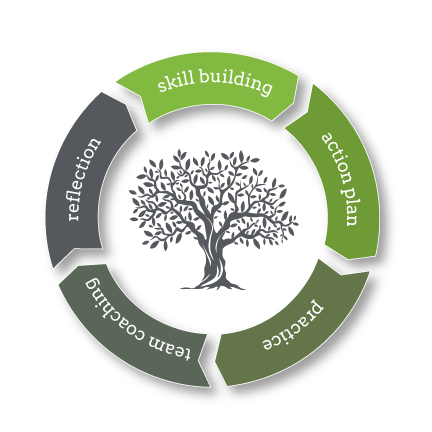
What really gets a team to the next level?
If you have a high potential team, how do you shift them to a high performing team?
Many would say, give them top notch training and arm them with new skills. Others might say, get them a coach to draw out their greatest potential. I would say, it’s not either, it’s both: the key is integration.
Let me explain.
Leaders often tell me that their team is lacking certain skills and the absence of those skills is holding them back. So, I spend a reasonable amount of time working with a leader to understand the gap between where the team is and where the leader would like them to be.
CYCLE FOR TEAM DEVELOPMENT SKILL BUILDING
SKILL BUILDING
Once we’ve identified those skills, we provide the team with great training; cutting edge content, new concepts and ideas to explore. But we don’t stop there! Without applying those skills in their unique business context, the team is unlikely to make the kind of changes the leader is hoping for. At the tail end of each training session, we shift to integration. We ask the team, “Now that you’ve learned these new skills, how will you apply them? What are you willing to try?”
ACTION PLAN
If you have a smart team, they will connect the dots and integrate the learning into an action plan. When the team gets back to the grind, however, they are likely to drop the ball and go back to an older, more comfortable way of working. To embed accountability, we encourage each person to declare their commitment with the team.
PRACTICE
We encourage real play, not role play. Life is a learning lab and team members learn best when they are actually doing. We ask them to observe themselves in the moment and see what emotions and reactions come up. “Lean in,” we tell them, “it’s going to be uncomfortable, but discomfort is part of the learning process.” What’s important is that they try something new.
TEAM COACHING
We engage the team in a conversation; a safe place to explore what worked and what didn’t. By outwardly sharing those insights we are accomplishing two things; everyone learns from each other and the conversation builds trust and team cohesion.
REFLECTION
Personal reflection is a key element of the learning cycle, and typically the part that gets missed. As the team leaves the session, we ask my all-time favourite coaching question: “If you had to do it over again, what might you do differently?” With further reflection, it allows team members to refine their approach. The cycle of learning is complete; now it’s time to introduce a new skill!
As leaders, we often feel like we need to be the expert, provide the perfect training program, or deliver the exact right motivation. But when you create a culture that lets high performers develop their skills and integrate them within the workplace, you’re showing your commitment to their ongoing growth. This is how you build an engaged, loyal, and high performing team. A team that learns together, stays together!”
- What skills are your team lacking?
- How are you developing the leaders of tomorrow?
- What is the ideal learning cycle for your team?
If you would like a thought partner to curate the ideal content for your team, give me a shout!
![]()

